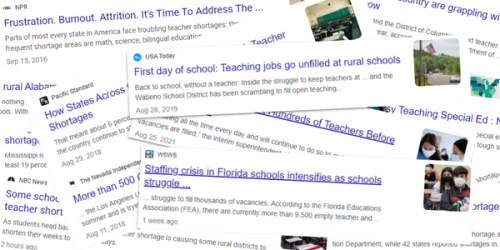Of the many policies education leaders have available to them to attract and retain teachers, pay is among the most powerful. Some states and districts have responded to recent teacher staffing challenges by increasing salaries across the board—a much-needed measure for all teachers.
However, salary increases for all teachers will not necessarily solve teacher shortages concentrated in certain subjects and schools. As more (and more nuanced) data comes out about teacher shortages, it has become increasingly clear that there is large variation in the extent of teacher vacancies by state, school, and subject.1 If states and school districts want to use compensation as a means of solving staffing challenges, then they need to start thinking and acting more strategically about teacher pay.
Research has shown repeatedly that, although not a panacea, strategic pay is an effective tool to attract and retain teacher talent to hard-to-staff schools and subjects,2 with some forms of strategic pay appearing to be related to higher teacher diversity. In this District Trendline, we examine if and how 148 large districts3 across the U.S. use strategic pay to attract and retain teachers where they need them the most. We pay particular attention to (1) special education as the subject with the most persistent staffing challenges, and (2) how districts with varying levels of students living in poverty use strategic pay to attract and retain teachers in hard-to-staff schools.
How are districts using strategic pay to attract teachers to hard-to-staff subjects?
The shortage areas states report to the federal government4 show clear differences among teacher vacancies by subject.
Figure 1.
Recent surveys by the U.S. Department of Education also show that schools with higher levels of students living in poverty are more likely to have teacher vacancies.5 The disparities in teacher shortages cannot be solved by a one-size-fits-all intervention.
Contracts and school board documents in 73% of the districts in our sample indicate some form of extra pay for teachers in hard-to-staff subjects,6 with the maximum pay available averaging $3,900 per year in those districts that offer it.
The level of specificity of those provisions varies widely. Some districts make it clear to prospective teachers of hard-to-staff subjects what type of pay they can expect, while others are more vague, which reduces the power of this extra pay as a recruitment tool. The Hawaii Department of Education specifies, for example, that special education teachers earn $10,000 extra annual pay, and teachers of Hawaiian language immersion earn $8,000 of additional pay each year. In contrast, New Haven Public Schools‘ (CT) contract indicates that “(i)n the event that the Board determines there is a shortage in a particular specialty, it may offer financial hiring incentives it deems appropriate to effectuate a hire (…) on a case-by-case basis and (…) shall not constitute a practice or precedent.” (Emphasis ours.)
As Figure 1 shows, and other research has found,7 special education is the subject area with the most prevalent staffing challenges. What do we find when we take a closer look at additional pay for special education teachers? For special education teachers in particular, the average additional pay is $2,500/year, meaning that teachers of other designated shortage areas make more, on average, than special education teachers (see Figure 2).
Few districts surpass the threshold of additional pay that research suggests would yield best results for attracting or retaining teachers to areas where they are most needed (7.5% of base pay or roughly equivalent to $5,000/year for the average teacher in the U.S.).8 In our sample of 148 large districts, only 13 districts offer additional pay that surpasses the $5,000/year threshold to attract teachers to designated hard-to-staff subjects. For special education teachers, only six districts offer additional pay that is greater than $5,000/year.
Figure 2.
Next, we compare the difference in additional pay for special education teachers with the extra pay that teachers with master’s degrees receive.
About half of the districts in our sample either don’t offer (58 districts) or don’t specify (17 districts) the amount of differentiated pay for special education teachers either in salary schedules, contracts, or other district documentation. In contrast, most districts’ salary schedules spell out clearly the pay differential that teachers receive when they hold a master’s degree, with 90% (133 districts) offering extra pay for teachers with a master’s degree. The pay increases for master’s degrees differ considerably across districts, averaging $6,400/year, which is considerably higher than differentiated pay for teaching special education. Notably, 10 districts9 offer additional pay for special education teachers but no additional pay for having a master’s degree.
The following graph illustrates the prevalence and size of extra pay for master’s degrees compared with extra pay for teaching special education. With each circle representing a district, two facts stand out. First, note the cluster of red circles on the left vertical axis, which means $0 additional pay for special education, but significant amounts of additional pay for master’s degrees (which, with few exceptions, are not linked to student achievement).10 Almost half of the districts in our sample (70 districts) do not offer or specify extra pay to attract and retain special education teachers, but offer on average $6,600 extra pay for master’s degrees. Second, relatively fewer green circles (to the right of the diagonal line) means that only a small proportion of large districts (20%, or 31 districts) offer higher additional pay to teachers of special education than to teachers with master’s degrees. It is no surprise, then, that school districts in the U.S. are replete with teachers holding master’s degrees11 and struggling to hire special educators.
Figure 3.
How are districts using strategic pay to attract teachers to hard-to-staff schools?
At an average of $5,000/year among the 66 large districts that offer it, the amount of differentiated pay for teachers in hard-to-staff schools tends to be larger but less prevalent than that for teachers in hard-to-staff subjects. Differentiated pay for teachers in hard-to-staff schools12 only appears in 45% of the contracts or school board documents in our district sample, and just as is the case with additional pay for hard-to-staff subjects, the language varies widely. In our sample, only 31% of district contracts or school board documents include specific language that allows prospective teachers to have clear expectations regarding additional pay to work in hard-to-staff schools.
It is important to note that teachers of color are more likely to work in hard-to-staff schools, which means that this type of strategic pay can be an effective tool to not only retain teachers working in these schools, but specifically to encourage teachers of color to remain in a district’s workforce.
Figure 4.
The contract in Denver Public Schools (CO), for example, specifies that “(a)ll Educators who work in a Title I school will receive $2,000/year in a non-base building incentive. (…) Educators who are retained in a Highest Priority School will receive a $3,000 retention bonus, paid as a lump sum in the fall for returning bargaining unit members.” In contrast, Board Policy 4111 of Elk Grove Unified School Districts (CA) indicates that “(t)he Superintendent or designee may provide incentives to recruit credentialed teachers to teach in any district school ranked in the bottom half of the state Academic Performance Index. Such incentives may include, but are not limited to, signing bonuses, improved work conditions, teacher compensation or housing subsidies.” (Emphasis ours.) No further evidence of such incentives was found in the district’s documentation.
A breakdown of districts’ use of differentiated pay for teachers in hard-to-staff schools by district poverty quintiles13 (using NCES SIDE indicator) shows that it is not necessarily the districts with a higher prevalence of students living in poverty that use differential pay the most. As the graph below (Figure 5) shows, 62% of districts in our sample in the second lowest quintile (meaning more affluent districts) use differentiated pay, compared to 57% of the highest poverty districts. In districts with very high levels of poverty, such as Detroit Public Schools Community District (MI), it might make little sense to differentiate, as most schools would qualify as “high-need” as traditionally defined, yet other districts in the top poverty quintiles (such as Rochester City School District in New York) do differentiate salaries, since there are always relative degrees of need.
Figure 5.
Of note, districts in the lowest poverty quintile make little use of monetary incentives to attract and retain teachers to hard-to-staff schools. This is not necessarily due to the absence of need. There are 57 school districts in our 148-district sample that are categorized in the lowest poverty quintile, 32 of which have a number of schools with average income below two times the poverty line. Twenty of those districts make no use of differentiated pay to attract teachers to hard-to-staff schools.
Conclusion
Differentiated pay is still an underutilized hiring and retention strategy by school districts, even though research shows that it is a strategy that serves to attract and retain teachers into the schools and subject areas that often face the most difficult staffing challenges.
A district’s compensation strategy is one of its main levers to attract teachers and to build a diverse teacher workforce, so districts ought to evaluate that strategy regularly against the district’s goals and needs. Even though teacher pay is usually set at least a year in advance, and often for multiple years at a time, it can be a dynamic instrument that adapts to the needs of the district when used and revised strategically.
The way teacher pay is structured speaks volumes about the district’s and teacher association’s priorities. In most districts, compensation structures signal that they value master’s degrees more than they value filling special education vacancies. District leaders need to be asking themselves: “What is my compensation strategy saying?” coupled with “Is that the best way to serve students, especially those that need it the most?”
To read more about how districts are using ESSER funds for one time financial incentives and strategic teacher pay, see this NCTQ review of COVID-related incentives for teachers during the 2021-22 school year as well this December 2021 brief from our colleagues at the Edunomics Lab: How COVID-19 Ushered In A Wave of Promising Teacher Pay Reforms.
More like this

Making Secretary Cardona’s vision for the teaching profession a reality
Beyond the important areas outlined in the Secretary’s remarks, we see two big challenges to the goal of access and equity to quality teachers that have yet to be addressed.

Strategies to build a sustainable special education teacher workforce
An examination of incentives offered by states and large school districts.

The revolutionary retention strategy of investing in beginning teachers
We examine the extent to which beginning teachers are receiving any form of compensating differentials that would help increase teacher retention during the first few years in the classroom.
Endnotes
- Nguyen, T. D., Lam, C. B. and Bruno, P. (2022). Is there a national teacher shortage? A systematic examination of reports of teacher shortages in the United States. (EdWorkingPaper: 22-631). Annenberg Institute at Brown University: https://doi.org/10.26300/76eq-hj32; National Center for Education Statistics (NCES) and Census Bureau (2022). School Pulse Panel: June 2022 [Data set]. United States Department of Education and United States Department of Commerce. https://ies.ed.gov/schoolsurvey/spp/.
- Glazerman, S., Protik, A., Teh, B. R., Bruch, J., & Max, J. (2013). Transfer Incentives for High-Performing Teachers: Final Results from a Multisite Randomized Experiment. NCEE 2014-4003. National Center for Education Evaluation and Regional Assistance; Cowan, J., & Goldhaber, D. (2018). Do bonuses affect teacher staffing and student achievement in high poverty schools? Evidence from an incentive for national board certified teachers in Washington State. Economics of Education Review, 65, 138–152. https://doi.org/10.1016/j.econedurev.2018.06.010; Swain, W. A., Rodriguez, L. A., & Springer, M. G. (2019). Selective retention bonuses for highly effective teachers in high poverty schools: Evidence from Tennessee. Economics of Education Review, 68, 148-160.
- The NCTQ sample of districts includes 148 school districts in the United States: the 100 largest districts in the country, the largest district in each state, and the member districts of the Council of Great City Schools.
- U.S. Department of Education (2022). Teacher Shortage Areas. https://tsa.ed.gov/#/home/.
- National Center for Education Statistics (NCES) and Census Bureau (2022). School Pulse Panel: June 2022 [Data set]. United States Department of Education and United States Department of Commerce. https://ies.ed.gov/schoolsurvey/spp/.
- Any subject area where the state educational agency or district authority has determined there is a shortage of qualified teachers; typically mathematics, science, foreign languages, bilingual education or special education.
- McVey, K. P., & Trinidad, J. (2019). Nuance in the Noise: The Complex Reality of Teacher Shortages. Bellwether Education Partners; Goldhaber, D., & Gratz, T. (2022). School District Staffing Challenges in a Rapidly Recovering Economy. CALDER “Flash” Brief No. 29-0122. National Center for Analysis of Longitudinal Data in Education Research (CALDER).
- Pham, L. D., Nguyen, T. D., & Springer, M. G. (2020). Teacher Merit Pay: A Meta-Analysis. American Educational Research Journal, 0002831220905580.
- Aldine Independent School District (TX), Cleveland Metropolitan School District (OH), Cumberland County Schools (NC), Dallas Independent School District (TX), Douglas County School District (CO), Guilford County Schools (NC), Hillsborough County Public Schools (FL), Houston Independent School District (TX), Indianapolis Public Schools (IN), and Wake County School District (NC).
- Boyd, D., Lankford, H., Loeb, S., Rockoff, J., & Wyckoff, J. (2008). The narrowing gap in New York City teacher qualifications and its implications for student achievement in high-poverty schools. Journal of Policy Analysis and Management, 27(4), 793-818; Ladd, H. F., Clotfelter, C. T., & Vigdor, J. L. (2007). How and why do teacher credentials matter for student achievement (NBER Working Paper 142786); Rivkin, S. G., Hanushek, E. A., & Kain, J. F. (2005). Teachers, schools, and academic achievement. Econometrica, 73(2), 417-458; Horn, A. S., & Jang, S. T. (2017). The Impact of Graduate Education on Teacher Effectiveness: Does a Master’s Degree Matter? MHEC Research Brief. Midwestern Higher Education Compact; Bastian, K. C. (2019). A degree above? The value-added estimates and evaluation ratings of teachers with a graduate degree. Education Finance and Policy, 14(4), 652-678.
- Institute of Education Sciences (2019). National Teacher and Principal Survey. Percentage distribution of public school teachers, by highest degree earned and state: 2017–18. National Center for Education Statistics. https://nces.ed.gov/surveys/ntps/tables/ntps1718_fltable04_t1s.asp.
- Hard-to-staff schools include but are not limited to schools designated as “high-need,” which are most commonly defined as those schools with the lowest student performance or the highest rates of students living in poverty.
- Quintiles are based on the percentage of schools in the district where the average family income is below two times the poverty line (the federal guideline to qualify for reduced price meals).

